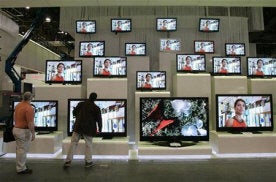Digital TV is on the way. And in case you’ve missed the persistent FCC ads, the switch to DTV means analog televisions will no longer work come February 2009. While plenty has been written about what the DTV switch means for TVs with rabbit ears, little has been said about the DTV transition on PCs. In most cases, PCs with TV tuner cards connected to a cable television provider will not be affected, but those relying on over-the-air broadcasts are likely to lose their TV signals post DTV transition.
|
|
|
|
|
REUTERS/Steve Marcus
Exhibitors look over Samsung televisions during last year’s Consumer Electronics Show in Las Vegas. Despite suggestions that the nation is ill-prepared for the conversion to digital TV, the Department of Commerce plans to help subsidize the switchover. |
||
What’s more, over time even cable-connected PCs will not be immune to the impact of digital television. Many cable providers are starting to reduce the number of analog broadcasts that they carry to make room for the bandwidth demands of digital and high-definition broadcasts—a change that translates to fewer channels for the TV tuner-enabled PC.
Further complicating the issue is that many cable providers are now offering direct digital broadcasts using a technology called QAM (quadrature amplitude modulation) for both standard-definition and high-definition video. In some cases, the cable provider may scramble the QAM signal, which means a set-top cable box is a must-have item. However, many cable providers are starting to offer channels with Clear QAM, which is unscrambled and allows viewers to watch content by using a QAM-enabled tuner.
While all of this may be good news to the typical TV viewer, the simple fact remains that thanks to all of the changes and options, watching TV on a PC has become more complicated than ever, and that creates opportunities for system builders looking to jump on the digital TV bandwagon.

